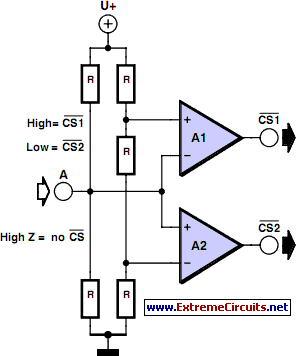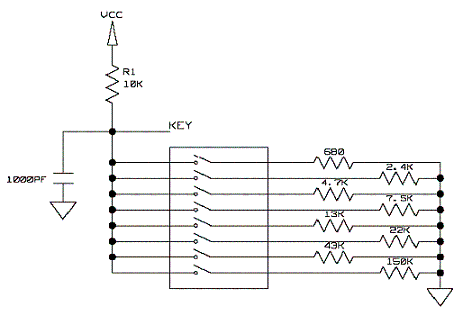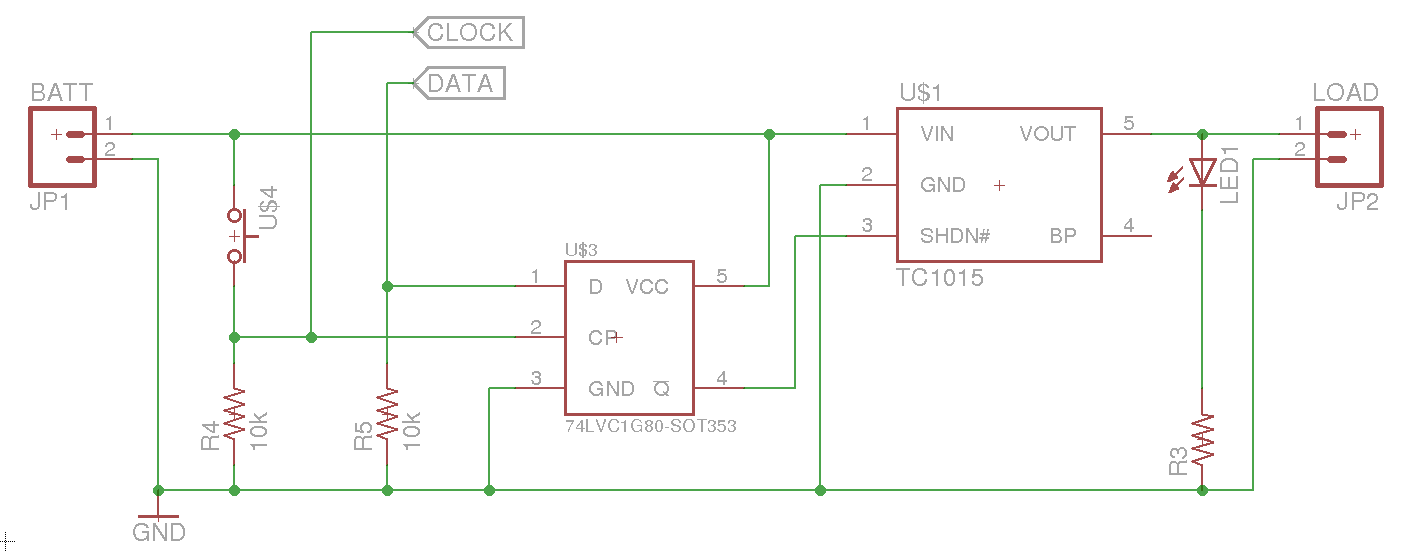
Multitasking Pins

It is entirely logical that low-cost miniature microcontrollers have fewer pins than their larger counterparts, sometimes too few. Consideration has been given to how to economize on pins by making them perform multiple functions. One approach is to exploit the high-impedance feature of a tri-state output. In this manner, the signal produced by the high-impedance state could be utilized, for example, as a Chip Select (CS) signal for two integrated circuits (ICs) or as a Read/Write (RD/WR) signal. The circuit requires two operational amplifiers or comparators sharing a single operating voltage of 5 V, with outputs capable of achieving full Low and High levels in a 5-V operation, preferably using rail-to-rail output types. Suitable examples include the LM393 or LM311. The resistances in the voltage dividers within this circuit are uniformly 10 kΩ. Consequently, input A is set at half the operating voltage (2.5 V), assuming no external connection to the input or that the microcontroller pin connected is in a high-impedance state. The non-inverting input of IC1A is at two-thirds, and the inverting input of IC1B is at one-third of the operating voltage, ensuring that both outputs are initially set to High state. If the microcontroller pin at input A transitions to Low, the output of IC1B goes Low while that of IC1A switches to High. Conversely, if input A is High, the states are reversed.
The described circuit leverages the tri-state output capability of microcontrollers to efficiently manage multiple signals while minimizing the number of required pins. By using two operational amplifiers (op-amps), such as the LM393 or LM311, the circuit can perform logical operations based on the state of input A. The configuration utilizes voltage dividers to establish reference levels for the op-amps, allowing them to respond dynamically to changes in the input state.
In practical implementation, the circuit can be designed with two voltage dividers, each consisting of two 10 kΩ resistors. This setup creates reference voltages at 2.5 V, 1.67 V (two-thirds of 5 V), and 0.83 V (one-third of 5 V). When the microcontroller pin connected to input A is in a high-impedance state, the op-amps will maintain their outputs in a High state. However, when input A is driven Low, the output of IC1B will transition to Low, indicating that the corresponding IC should be activated, while IC1A's output will switch to High, signaling the other IC to deactivate or remain in a standby mode.
This design allows for efficient control of multiple ICs without the need for additional pins on the microcontroller, making it particularly useful in compact applications where space is limited. The use of rail-to-rail op-amps ensures that the output levels are fully compatible with the logic levels of the microcontroller, providing reliable operation in various digital applications.It`s entirely logical that low-cost miniature microcontrollers have fewer legs` than their bigger brothers and sisters some-times too few. The author has given some consideration to how to economise on pins, making them do the work of several.
It occurred that one could exploit the high-impedance feature of a tri-state output. In this way the signal produced by the high-impedance state could be used for example as a CS signal of two ICs or else as a RD/WR signal. All we need are two op-amps or comparators sharing a single operating voltage of 5 V and outputs capable of reaching full Low and High levels in 5-V operation (preferably types with rail-to-rail outputs).
Suitable examples to use are the LM393 or LM311. The resistances in the voltage dividers in this circuit are uniformly 10k. Consequently input A lies at half the operating voltage (2. 5V), assuming nothing is connected to the input - or the microcontroller pin connected is at high impedance. The non-inverting input of IC1A lies at two-thirds and the inverting input of IC1B at one third of the operating voltage, so that in both cases the outputs are set at High state.
If the microcontroller pin at input A becomes Low, the output of IC1B becomes Low and that of IC1A goes High. If A is High, everything is reversed. 🔗 External reference
The described circuit leverages the tri-state output capability of microcontrollers to efficiently manage multiple signals while minimizing the number of required pins. By using two operational amplifiers (op-amps), such as the LM393 or LM311, the circuit can perform logical operations based on the state of input A. The configuration utilizes voltage dividers to establish reference levels for the op-amps, allowing them to respond dynamically to changes in the input state.
In practical implementation, the circuit can be designed with two voltage dividers, each consisting of two 10 kΩ resistors. This setup creates reference voltages at 2.5 V, 1.67 V (two-thirds of 5 V), and 0.83 V (one-third of 5 V). When the microcontroller pin connected to input A is in a high-impedance state, the op-amps will maintain their outputs in a High state. However, when input A is driven Low, the output of IC1B will transition to Low, indicating that the corresponding IC should be activated, while IC1A's output will switch to High, signaling the other IC to deactivate or remain in a standby mode.
This design allows for efficient control of multiple ICs without the need for additional pins on the microcontroller, making it particularly useful in compact applications where space is limited. The use of rail-to-rail op-amps ensures that the output levels are fully compatible with the logic levels of the microcontroller, providing reliable operation in various digital applications.It`s entirely logical that low-cost miniature microcontrollers have fewer legs` than their bigger brothers and sisters some-times too few. The author has given some consideration to how to economise on pins, making them do the work of several.
It occurred that one could exploit the high-impedance feature of a tri-state output. In this way the signal produced by the high-impedance state could be used for example as a CS signal of two ICs or else as a RD/WR signal. All we need are two op-amps or comparators sharing a single operating voltage of 5 V and outputs capable of reaching full Low and High levels in 5-V operation (preferably types with rail-to-rail outputs).
Suitable examples to use are the LM393 or LM311. The resistances in the voltage dividers in this circuit are uniformly 10k. Consequently input A lies at half the operating voltage (2. 5V), assuming nothing is connected to the input - or the microcontroller pin connected is at high impedance. The non-inverting input of IC1A lies at two-thirds and the inverting input of IC1B at one third of the operating voltage, so that in both cases the outputs are set at High state.
If the microcontroller pin at input A becomes Low, the output of IC1B becomes Low and that of IC1A goes High. If A is High, everything is reversed. 🔗 External reference



